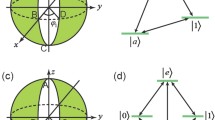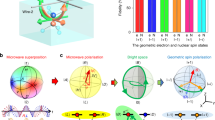Abstract
Embraced with the built-in noise resilience feature for quantum evolutions, holonomic quantum computation provides high fidelity quantum gate operations, and thus has attracted much attention from researchers for stepping forward the development of robust quantum computation. Here in this work, we propose a physically feasible scheme to perform scalable non-adiabatic non-Abelian holonomic quantum computations in a physical system whose Hamiltonian is described by a quantum spin model with tunable coupling strengths. Our scheme is realizable from experimentally achievable Hamiltonian in superconducting-qubit systems and therefore, it is of practical importance in implementing protected quantum computation.

Similar content being viewed by others
References
Berry, M.V.: Quantal phase factors accompanying adiabatic changes. Proc. R. Soc. A 392, 45 (1984)
Aharonov, Y., Anandan, J.: Phase change during a cyclic quantum evolution. Phys. Rev. Lett. 58, 1593 (1987)
Wilczek, F., Zee, A.: Appearance of gauge structure in simple dynamical systems. Phys. Rev. Lett. 52, 2111 (1984)
Anandan, J.: Non-adiabatic non-abelian geometric phase. Phys. Lett. A 133, 171 (1988)
Jones J. A., Vedral V., Ekert A.: Castagnoli G, Geometric quantum computation using nuclear magnetic resonance, Nature (London) 403 869 (2000)
Wang, B., Matsumoto, K.: Nonadiabatic conditional geometric phase shift with NMR. Phys. Rev. Lett. 87, 097901 (2001)
Zhu, S.L., Wang, Z.D.: Unconventional geometric quantum computation. Phys. Rev. Lett. 91, 187902 (2003)
Duan, L.M., Cirac, J.I., Zoller, P.: Geometric manipulation of trapped ions for quantum computation. Science 292, 1695 (2001)
Zanardi, P., Rasetti, M.: Holonomic quantum computation. Phys. Lett. A 264, 94 (1999)
Sjöqvist, E., et al.: Non-adiabatic holonomic quantum computation. New J. Phys. 14, 103035 (2012)
Xu, G.F., Zhang, J., Tong, D.M., Sjöqvist, E., Kwek, L.C.: Nonadiabatic holonomic quantum computation in decoherence-free subspaces. Phys. Rev. Lett. 109, 170501 (2012)
Zhang, J., Kwek, L.C., Sjöqvist, E., Tong, D.M., Zanardi, P.: Quantum computation in noiseless subsystems with fast non-abelian holonomies. Phys. Rev. A 89, 042302 (2014)
Wang, Y.M., Zhang, J., Wu, C.F., You, J.Q., Romero, G.: Holonomic quantum computation in the ultrastrong-coupling regime of circuit QED. Phys. Rev. A 94, 012328 (2016)
Liu, B.J., Huang, Z.H., Xue, Z.Y., Zhang, X.D.: Superadiabatic holonomic quantum computation in cavity QED. Phys. Rev. A 95, 062308 (2017)
Ramberg, N., Sjöqvist, E.: Environment-assisted holonomic quantum Maps. Phys. Rev. Lett. 122, 140501 (2019)
Abdumalikov, A.A., Jr., et al.: Experimental realization of non-abelian non-adiabatic geometric gates. Nature 496, 482 (2013)
Xu, Y., et al.: Single-loop realization of arbitrary nonadiabatic holonomic single-qubit quantum gates in a superconducting circuit. Phys. Rev. Lett. 121, 110501 (2018)
Feng, G., Xu, G., Long, G.: Experimental realization of nonadiabatic holonomic quantum computation. Phys. Rev. Lett. 110, 190501 (2013)
Zhu, Z., et al.: Single-loop and composite-loop realization of nonadiabatic holonomic quantum gates in a decoherence-free subspace. Phys. Rev. Applied 12, 024024 (2019)
Zu, C., et al.: Experimental realization of universal geometric quantum gates with solid-state spins. Nature (London) 514, 72–75 (2014)
Sekiguchi, Y., Niikura, N., Kuroiwa, R., Kano, H., Kosaka, H.: Optical holonomic single quantum gates with a geometric spin under a zero field. Nat. Photonics 11, 309 (2017)
Mousolou, V.A., Canali, C.M., Sjöqvist, E.: Universal non-adiabatic holonomic gates in quantum dots and single-molecule magnets. New J. Phys. 16, 013029 (2014)
Zhang, J., Devitt, S.J., You, J.Q., Nori, F.: Holonomic surface codes for fault-tolerant quantum computation. Phys. Rev. A 97, 022335 (2018)
You, J.Q., Nori, F.: Atomic physics and quantum optics using superconducting circuits. Nature 474, 589–597 (2011)
Devoret, M.H., Schoelkopf, R.J.: Superconducting circuits for quantum information: an outlook. Science 339, 1169–1174 (2013)
Krantz, P., Kjaergaard, M., Yan, F., Orlando, T.P., Gustavsson, S., Oliver, W.D.: A quantum engineer’s guide to superconducting qubits. Appl. Phys. Rev. 6, 021318 (2019)
Huang, H.-L., Wu, D., Fan, D., Zhu, X.: 2020 Superconducting quantum computing: a review. Sci. China Inf. Sci. 63, 180501 (2020)
Kelly, J., et al.: State preservation by repetitive error detection in a superconducting quantum circuit. Nature (London) 519, 66–69 (2015)
Ofek, et al.: Extending the lifetime of a quantum bit with error correction in superconducting circuits. Nature (London) 536, 441–445 (2016)
Yoshihara, F., Fuse, T., Ashhab, S., Kakuyanagi, K., Saito, S., Semba, K.: Superconducting qubit-oscillator circuit beyond the ultrastrong-coupling regime. Nat. Phys. 13, 44–47 (2017)
Chen, Z., et al.: Single-photon-driven high-order sideband transitions in an ultrastrongly coupled circuit-quantum-electrodynamics system. Phys. Rev. A 96, 012325 (2017)
Barends, R., et al.: Digital quantum simulation of fermionic models with a superconducting circuit. Nat. Commun. 6, 7654 (2015)
Mei, F., Chen, G., Tian, L., Zhu, S.-L., Jia, S.: Robust quantum state transfer via topological edge states in superconducting qubit chains. Phys. Rev. A 98, 012331 (2018)
Li, S., Chen, T., Xue, Z.: Fast holonomic quantum computation on superconducting circuits with optimal control. Adv. Quantum Tech. 3(3), 2000001 (2020)
Chen, T., Zhang, J., Xue, Z.Y.: Nonadiabatic holonomic quantum computation on coupled transmons with ancillaries. Phys. Rev. A 98, 052314 (2018)
Wu, C.F., Wang, Y.M., Feng, X.L., Chen, J.L.: Holonomic quantum computation in surface codes. Phys. Rev. Applied 13, 014055 (2020)
Wang, Y.M., Su, Y., Chen, X., Wu, C.F.: Dephasing-protected scalable holonomic quantum computation on a rabi lattice. Phys. Rev. Appl. 14, 044043 (2020)
You, J.Q., Liu, Y., Sun, C.P., Nori, F.: Persistent single-photon production by tunable on-chip micromaser with a superconducting quantum circuit. Phys. Rev. B 75, 104516 (2007)
Paaum F. G.: Superconducting Flux Qubits: Quantum Chains and Tunable Qubits Technische Universiteit Delft (2019)
Schwarz, M.J., et al.: Gradiometric flux qubits with a tunable gap. New J. Phys. 15, 045001 (2013)
Gu X., Chen S., Liu Y.: Topological edge states and pumping in a chain of coupled superconducting qubits, arXiv:1711.06829 [Quant-Ph] (2017)
Mei, F., You, J.-B., Nie, W., Fazio, R., Zhu, S.-L., Kwek, L.C.: Simulation and detection of photonic chern insulators in a one-dimensional circuit-QED lattice. Phys. Rev. A 92, 041805 (2015)
You, J.Q., Wang, Z.D., Zhang, W., Nori, F.: Encoding a qubit with majorana modes in superconducting circuits. Sci. Rep. 4, 05535 (2014)
Grajcar, M., Liu, Y., Nori, F., Zagoskin, A.M.: Switchable resonant coupling of flux qubits. Phys. Rev. B 74, 172505 (2006)
Plourde, B.L.T., et al.: Entangling flux qubits with a bipolar dynamic inductance. Phys. Rev. B 70, 140501 (2004)
Bertet, P., Harmans, C.J.P.M., Mooij, J.E.: Parametric coupling for superconducting qubits. Phys. Rev. B 73, 064512 (2006)
Niskanen, A.O., et al.: Quantum coherent tunable coupling of superconducting qubits. Science 316, 723 (2007)
Wootters, W.K.: Entanglement of formation of an arbitrary state of two qubits. Phys. Rev. Lett. 80, 2245 (1998)
Acknowledgements
G.C.W. acknowledges the Fundamental Research Funds for the Central Universities (Grant No. 2412020FZ026).
Author information
Authors and Affiliations
Corresponding author
Additional information
Publisher's Note
Springer Nature remains neutral with regard to jurisdictional claims in published maps and institutional affiliations.
Appendix: The two-qubit gate
Appendix: The two-qubit gate
As presented in the main text, a holonomic two-qubit gate \(U'\) (c.f. Eq. (18)) can be realized with assistance of the auxiliary qubit. It is well-known that concurrence can be used to evaluate the entanglement of two-qubit states. For any pure state \(|{\psi }{{\rangle }_{12}}\) on a pair of quantum systems 1 and 2, the concurrence is defined as [48]
with \({{| {\tilde{\psi }} \rangle }_{12}}=\sigma _{y}^{1}\otimes \sigma _{y}^{2}{{\left| {{\psi }^{*}} \right\rangle }_{12}}\) and \({{\left| {{\psi }^{*}} \right\rangle }_{12}}\) is the complex conjugation of the state \({|\psi \rangle }_{12}\). Concurrence ranges from 0 to 1, with \(C =0\) for product state, and \(C=1\) for maximum entangled state. In the following, by calculating the concurrence of the two-qubit state before and after the two-qubit gate \(U'\), we prove that the gate \(U'\) performs an entangling operation. Suppose the initial state of the two-qubit system is an arbitrary product state,
where the coefficients a, b, c, d are complex values. It can be easily checked that \(C({{|\psi \rangle }_{12}})=0\) for the initial product state \({{|\psi \rangle }_{12}}\). Applying the gate \(U'\) onto the state \(|\psi {{\rangle }_{12}}\), the two-qubit state becomes
For our transformed state \(|{\psi }'{{\rangle }_{12}}\), the concurrence is calculated to be
Therefore, as long as the condition of \(abcd\ne 0\) is satisfied, \(C{{(|{\psi }'\rangle }_{12}}) \ne 0\), which indicates that \(|{\psi }'{{\rangle }_{12}}\) is an entangled state and the two-qubit gate \({U}'\) is an entangled gate. For example, suppose the initial product state reads
The state after applying the gate \(U'\) is then given by
It is clear that \(|{\psi }'{{\rangle }_{12}}\) becomes an entangled state.
Rights and permissions
About this article
Cite this article
Wang, Y., Wang, G., Zhou, H. et al. Auxiliary-qubit-assisted holonomic quantum gates on superconducting circuits. Quantum Inf Process 21, 10 (2022). https://doi.org/10.1007/s11128-021-03355-y
Received:
Accepted:
Published:
DOI: https://doi.org/10.1007/s11128-021-03355-y




